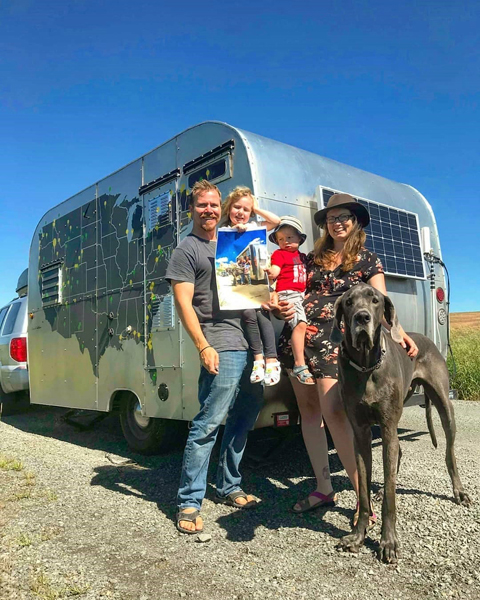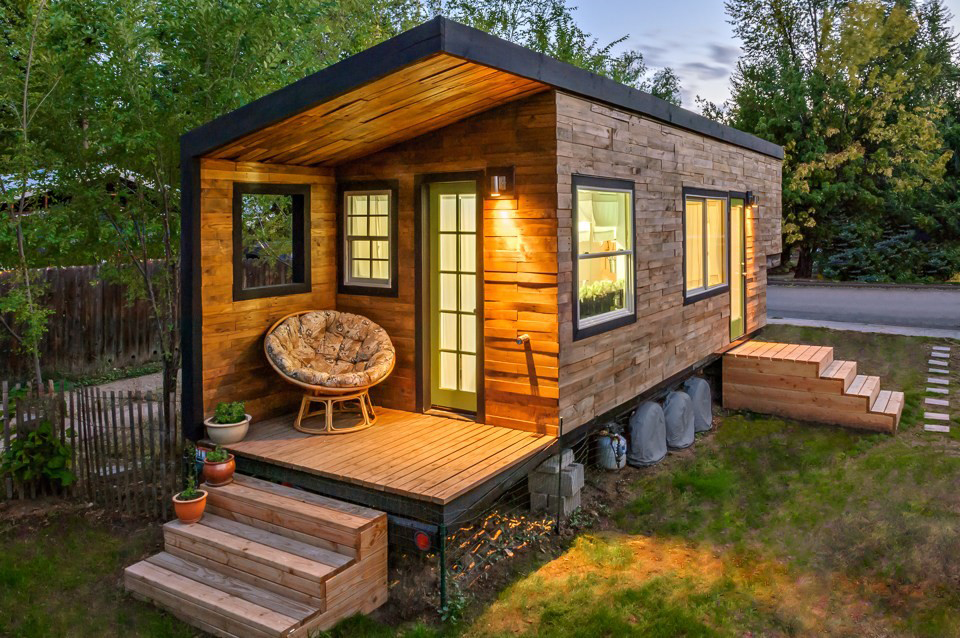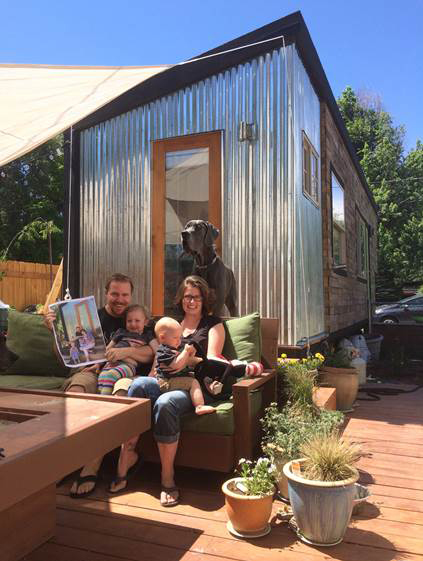Macy Miller, Architectural Designer and Tiny House Advocate
 Macy Miller is a mother, teacher, and an architectural designer. She designed and built her family's tiny house in 2011 which has been featured in TIME and Dwell magazines. After living tiny for four years and having two kids, her family downsized from their tiny house to a rebuilt vintage travel trailer to explore the U.S. National Parks. She remains a strong advocate of alternative living and small space dwelling. You can find her at her website MiniMotives.com.
Macy Miller is a mother, teacher, and an architectural designer. She designed and built her family's tiny house in 2011 which has been featured in TIME and Dwell magazines. After living tiny for four years and having two kids, her family downsized from their tiny house to a rebuilt vintage travel trailer to explore the U.S. National Parks. She remains a strong advocate of alternative living and small space dwelling. You can find her at her website MiniMotives.com.
What led you to your field?
I’ve always had a creative streak but loved math in school too. Someone early on once told me I should be an architect. I looked into that, it sounded neat then, and as I got older it still sounded like fun. As I became more aware of social issues, preservation of our planet and sustainability moved to the forefront of my goals. I learned that buildings were responsible for well over half of our pollution and figured if I could help effect change on the building front, even a little, I could have a shot at changing the world for the better!
I suppose after working in commercial architecture a few years I found it difficult to get people to care about their workspace enough to change their habits or care enough to make the best choice rather than the cheapest. Within residential designs, where occupants’ bottom lines are directly affected, it has become a lot more thrilling to teach about positive change, and I really feel like I am starting to effect that change in a way that I hoped to.
How does what you do relate to historic preservation?
The field of architecture relates a lot; I am not sure how what I do specifically relates, but I hope it has the effect of retaining the character of a community just a little bit longer by allowing growth to happen within the existing infrastructures of a community rather than having to expand up or out, often replacing historic icons (buildings) along the way.
Why do you think historic preservation matters?
You can change the entire character of a place by demolishing a few key elements around which that place was founded. If you change the character of a place, you alter the character of the people living in that place. People connect on a fundamental level with places they live, a lot of times that happens on a subconscious level. People take pride in their history, and if you don’t preserve that history for others to see it is much harder to take pride in your place. When people aren’t proud of their place they won’t have feelings of satisfaction and a sense of belonging, which are essential to happiness.
What courses do you recommend for students interested in this field?
I don’t recommend any courses for folks in my field unless they want to build a tiny house, then I recommend mine! ;-) (https://www.udemy.com/user/macy-miller/).
Do you have a favorite preservation project? What about it made it special?
It’s definitely not the preferred method of “preservation,” but I always love watching buildings be relocated. In Boise we had a beautiful historic neighborhood which became the center of downtown. It included the homes of very influential people over history, but no one lived there anymore. They were getting destroyed by squatters and ultimately detracting from the downtown core. It didn’t make sense for the area to remain residential any longer, but there were all these beautiful, historic homes that no one wanted destroyed either. The solution was to have the homes moved (https://www.idahostatesman.com/news/local/community/boise/article41562948.html). I find the whole process completely fascinating. It is not a simple process to relocate a building, but I am sure glad folks do in these cases! These homes now get a renewed life with owners who appreciate them and the state gets to retain its history! Win, win, win!
 Can you tell us what you are working on right now?
Can you tell us what you are working on right now?
Right now I am primarily working on raising well-rounded kids; it’s a big job! I still run a local Tiny House MeetUp group to help others on their path to tiny living, and I try very hard to make myself accessible to anyone who has tiny home questions or concerns, world-wide. They usually reach out to me via my email or the Facebook group I run, Tiny House People. I also run Tiny House Hosting, which aims to match landowners with tiny home owners, facilitating interactions and relationships and hopefully helping push the tiny house movement along the right path.
Alongside this, I am also actively working through code issues for tiny homes, locally. My goal is to make them more accessible as a housing type for anyone who chooses to live tiny. I was a part of the effort that incorporated the tiny house appendix into the 2018 International Residential Code (IRC). Late in 2016, my family and I flew to Kansas City to give our public testimony in favor of the appendix which was later adopted. I help others understand how they can act locally and lead the charge of incorporating that appendix into their own community. Idaho was the first state to adopt the appendix at the state level with the effort we put in. The next step for us is working through zoning barriers and setting a baseline that can be repeated elsewhere as needed.

How do you think national historic preservation programs help your community?
Our community is rich in history because of the public art projects that have been commissioned, our hard working historic preservation society, and a lot of caring individuals who show up when we need support. We are very lucky to live in a place that respects our cultural history and our natural landscapes. It helps everyone take a bit more pride in our community’s story!
Do you have any advice for novice preservationists?
Get involved, care about something! To quote Dr. Seuss, “Unless someone like you cares a whole awful lot, Nothing is going to get better. It's not.” Ask questions and show up.
The ACHP’s mission is “preserving America’s heritage;” can you give us an example of how your community is preserving its heritage?
One of the many things Idaho has going for it is our natural resources, open space, and landscapes. I don’t know anyone here who isn’t proud that we have such a connection to nature while still being a big ‘city’. That gets really hard to preserve when we have been one of the fastest growing communities in the country for as long as I can remember. All those people have to go somewhere, and for a lot of places that means the open spaces disappear. We have an exceptional group of passionate people, The Land Trust of the Treasure Valley (https://www.lttv.org/), who work hard every day to fight to keep some of our most coveted open spaces, open. Without that group, the dynamic of our community would have been absolutely decimated long ago!
How do you see the tiny house phenomenon evolving in the future?
My hope is that tiny homes can be just another housing option. Apartment, condo, home, tiny house. I hope tiny homes can be incorporated into the fabric of a city rather than being placed only in pockets. I hope they can become an asset to their communities, allowing their occupants more disposable income to spend within their community. I hope a network of movable tiny house ADU (Accessory Dwelling Unit) pads can be built so people have options and alternatives to getting stuck in a renting pattern that is often uneven. I hope that communities can be strengthened through the integration and interdependence of landowners and tiny home space renters. I hope tiny home space renters can offset house poor individuals, making their lives just a bit easier and freeing up more disposable income to be spent within their community, helping everyone thrive. I hope that work-force laborers don’t have to commute long distances and spend a ton on transportation just to have a job; I hope workers of all incomes can live near where they work. I hope they become a way for traveling professionals (nurses, teachers, contractors, etc.) to take their home so they don’t have to completely uproot their lives and re-establish ‘home’ at every new job site.
The fact is that our society is changing; how we work, live, and play has changed. Many people are location-independent or move regularly as a lifestyle. Having wheels on your home is an asset many people will continue to fight for because it offers solutions. I hope that building codes will continue to respond to these new needs, and I hope that zoning solutions can be found that makes a tiny home like any other type of safe housing option: available.
How do you navigate working with city/county governments?
Talk to them. The first thing to do is talk to them. City and county governments work for the people they serve. They can’t possibly be expected to know about a need if no one talks to them about their needs. In some cases, you may be educating them. That is ok; they are just people, too. Just start a discussion. Help find the information you need if they don’t already know about it. Cities are often expected to do too much with too little; any help you can provide is generally very appreciated!
What role does sustainability play in preservation?
The definition of sustainable is “able to be maintained.” It’s not just about the environment. To be sustainable you have to be able to anticipate needs and be relevant for years to come. It’s a tall order, and it doesn’t always work out, but you don’t usually throw the baby out with the bathwater. You do the best you can to preserve and use what you have as a commitment. I think that is what preservation is about, too. They are intertwined.
What advice do you have for people looking to contribute to preservation efforts through sustainable practices?
Think about a purchase, and do what you can; it starts at a very small scale. Sustainability or preservation shouldn’t be the only metric you use to make a decision, but it should be a metric. Is this a sound purchase? Will I use this? Can I use this another way? We live in a disposable society where “new” is usually thought of as better; I wish that mindset would change. New is often not nearly as good, and that mindset is destroying our communities! Something has to be done with all those old houses; we need to start dealing with the ramifications of our actions, reusing, renewing, and recycling where we can and in all realms of our day-to-day!
How important is it for community activists to speak up to make change?
It is imperative that community activists (and non-activists) show up and speak up! The hardest part is proving that people care. If no one shows up, elected officials don’t see that people care, and nothing changes. Or maybe everything changes for the worse. If you show up, you are not required to speak; that first time can be daunting. Push through it and go though, if only to observe. Then, when you’re comfortable, speak up!
Read more Q&A stories about the preservationists in your neighborhood!